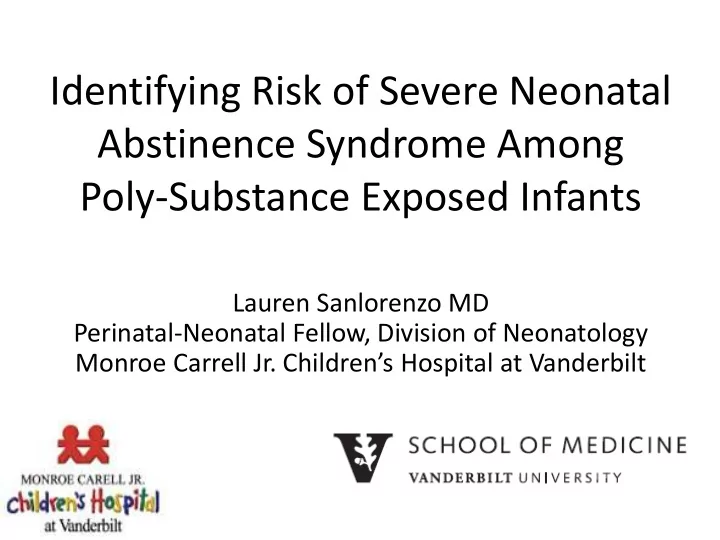

Identifying Risk of Severe Neonatal Abstinence Syndrome Among Poly-Substance Exposed Infants Lauren Sanlorenzo MD Perinatal-Neonatal Fellow, Division of Neonatology Monroe Carrell Jr. Children’s Hospital at Vanderbilt
Disclosures • No disclosures to report
Neonatal Abstinence Syndrome • Postnatal opioid withdrawal syndrome • Characterized by hyperactivity of central and autonomic nervous system and gastrointestinal tract • Emerging public health crisis across the USA McQueen et al. NEJM. 2016 Patrick et al. J Perinatol. 2015
Neonatal Abstinence Syndrome- 2 • Variable disease severity among opioid exposed infants • Poly-substance use is common among opioid using pregnant women • Benzodiazepine co-exposure may influence NAS severity Fitzsimons et al. J Sub Abuse Tx 2007 Dryden et al. BJOG 2009 Cleary et al Addiction 2012
Hypothesis • The prevalence of antenatal benzodiazepine exposure is higher among infants with pharmacologically treated NAS compared to infants with non-pharmacologically treated NAS.
Methods • Study Design : nested case-control study • Population : woman and infants enrolled in TennCare, Tennessee’s Medicaid program, in 2009-2011 • Data Source: prescription and hospital claims linked to vital statistics, hospital records, and toxicology tests
Primary Study Base • Inclusion Criteria: – Mother was 15-44 years old at the time of delivery – Mother enrolled in TennCare at least 30 days before delivery – Infant enrolled in TennCare within 30 days of delivery – Infants born between January 1, 2009 and December 31, 2011
Methods 112,847 maternal-infant dyads ICD-9-CM 779.5 1,086 maternal-infant dyads validated standardized adjudication process CASES : CONTROLS : n=598 n=224 Pharmacologically treated Non-pharmacologically NAS, LOS >5 days treated NAS
Exposure Definition • Benzodiazepine exposure during pregnancy: – Self-report of benzodiazepine use during pregnancy – Positive maternal urine toxicology test at time of delivery – Positive infant toxicology test at time of delivery (Urine, Meconium, Umbilical Cord, Blood)
Maternal Characteristics Maternal Non- Pharmacologically Characteristics pharmacologically treated NAS treated NAS (CASES) (CONTROLS) n=598 n=224 Age, yrs (mean) 25.5 26.2 Education, yrs (mean) 12 12 Race n (%) n (%) Black 4 (1.8) 15 (2.5) White 219 (98) 597 (97) Depression or Anxiety 120 (20) 41 (18) Hepatitis C Infection* 19 (8) 84 (14) * p-value <0.05
Infant Characteristics Infant Non- Pharmacologically Characteristics pharmacologically treated NAS treated NAS n (%) n (%) Preterm (<37weeks) 41 (18) 92 (15) Low Birth Weight 50 (22) 131 (21) (<2500g) Female 110 (49) 247 (45) Respiratory 44 (19) 165 (27) Complications* * p-value <0.05
Cohort Exposed to Multiple Opioid Preparations 48% 40% 37% 35% 20% 20% 6% 2% No Identified Short Acting Long Acting/MT Short Acting and Opioid Exposure Opioid Exposure Opioid Exposure Long Acting/MT Exposure Cases Controls MT- Maintenance Opioid Therapy
Poly-substance Exposed Infants Exposure Non- Pharmacologically p- pharmacologically Treated NAS value treated NAS n(%) n (%) Tobacco 176 (78) 471 (82) 0.25 Marijuana 68 (30) 155 (25) 0.20 Cocaine 19 (8) 66 (11) 0.28 Methamphetamine 5 (2) 20 (3) 0.41 Phencyclidine 2 (0.9) 9 (1.3) 0.60 Benzodiazepines 69 (30) 245 (40) 0.01 SSRIs 33 (14) 102 (17) 0.42
Benzodiazepine Exposure Increases Odds of Severe NAS Exposure aOR 95% CI Female 0.86 0.62-1.18 Low Birth Weight (<2500g) 1.08 0.70-1.66 Preterm (<37wks) .71 0.44-1.13 Short Acting Opioid 1.67 1.12-2.47 Long Acting/Maintenance Opioid 2.07 1.46-2.93 Tobacco 1.18 0.79-1.75 SSRI 1.16 0.75-1.81 Benzodiazepine 1.50 1.08-2.13 THC 0.79 0.55-1.13 Cocaine 1.33 0.76-2.32 Gabapentin 1.67 0.46-6.0 Maternal Hepatitis C 1.54 0.90-2.65
Conclusions • Benzodiazepine exposure is common in a population based cohort of infants with NAS • Overall, after accounting for multiple exposures, benzodiazepine exposure is independently associated with NAS severity • Population based methods overcame many of the limitations of prior work, demonstrating this relationship in univariate and multivariate analysis
Limitations • Data set restricted to one state, limiting generalizability • Benzodiazepine prescription claims limited during the study period; non-differential exposure misclassification
Implications • Providers caring for opioid-dependent pregnant women should be aware of adverse neonatal effects of antenatal benzodiazepine exposure • Tools used to predict NAS severity should account for benzodiazepine exposure
Thank you • Funding: Mentorship Team • Mentor • NICHD T32HD060554 (Cooper) – Stephen W. Patrick MD MPH MS • NIDA K23DA038720 (Patrick) • Research Team – William O. Cooper MD • John and Leslie Hooper MPH Neonatal-Perinatal – Faouzi Maalouf MD Endowment Fund – Judith Dudley – Shannon Stratton
Recommend
More recommend